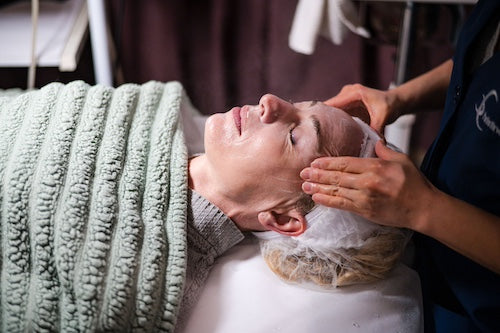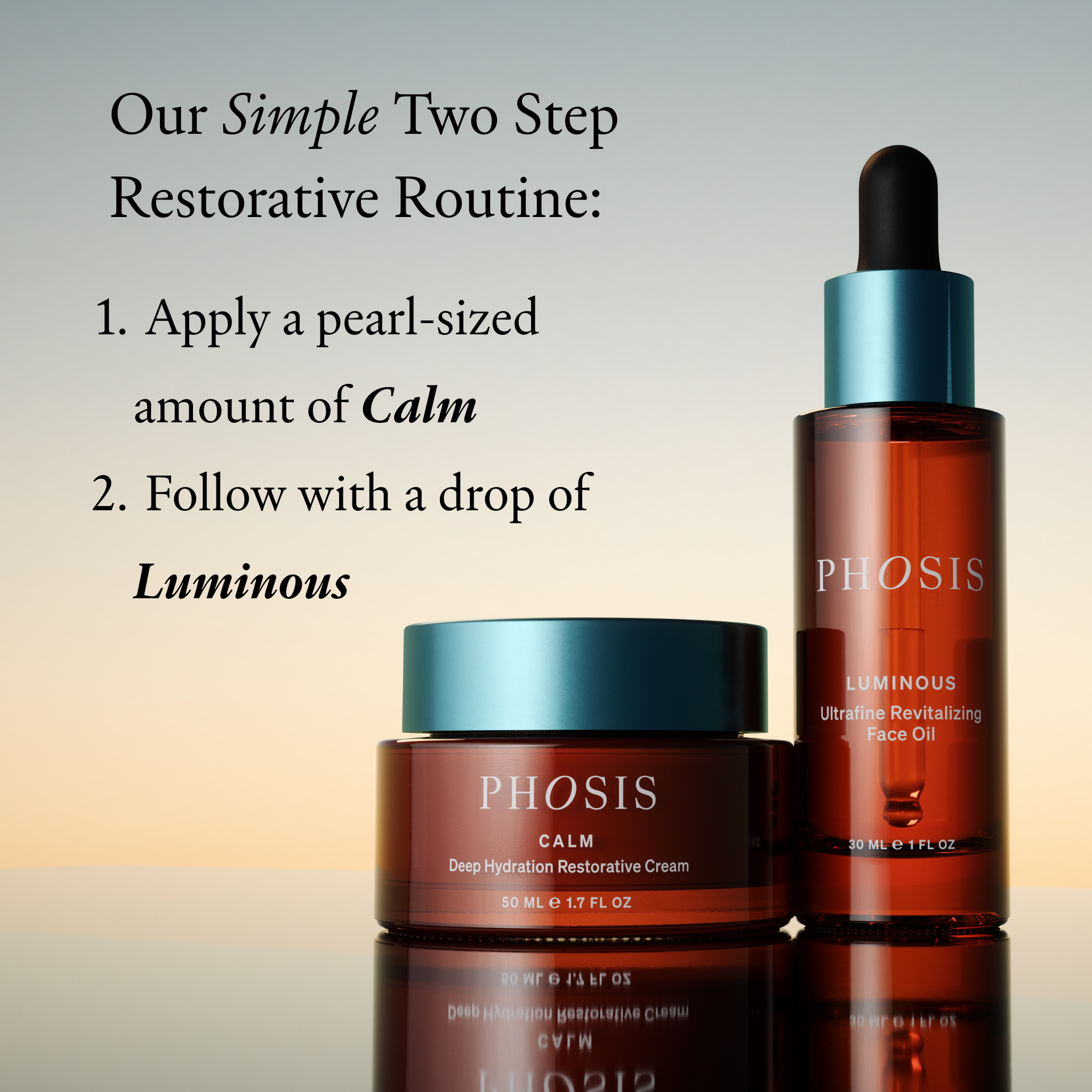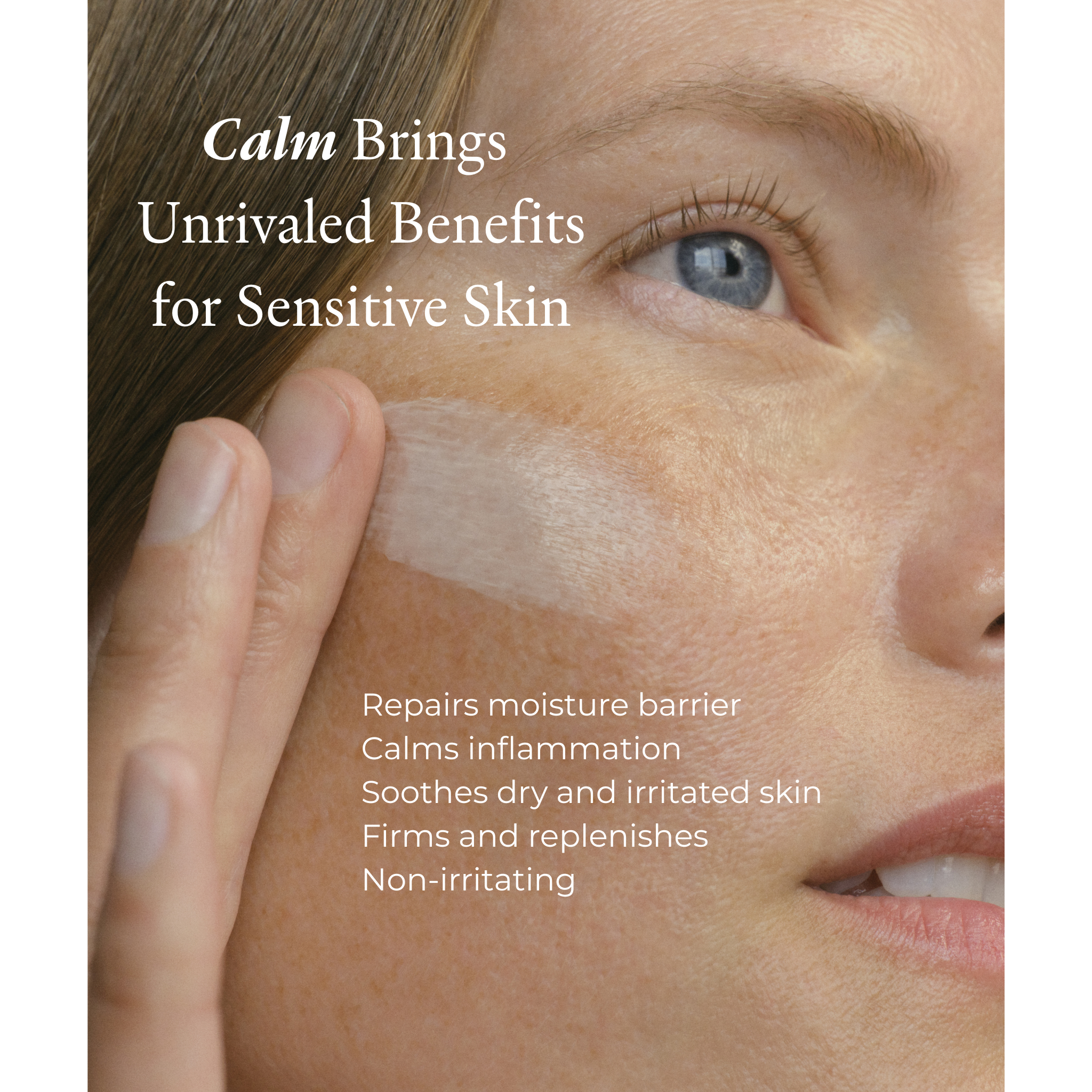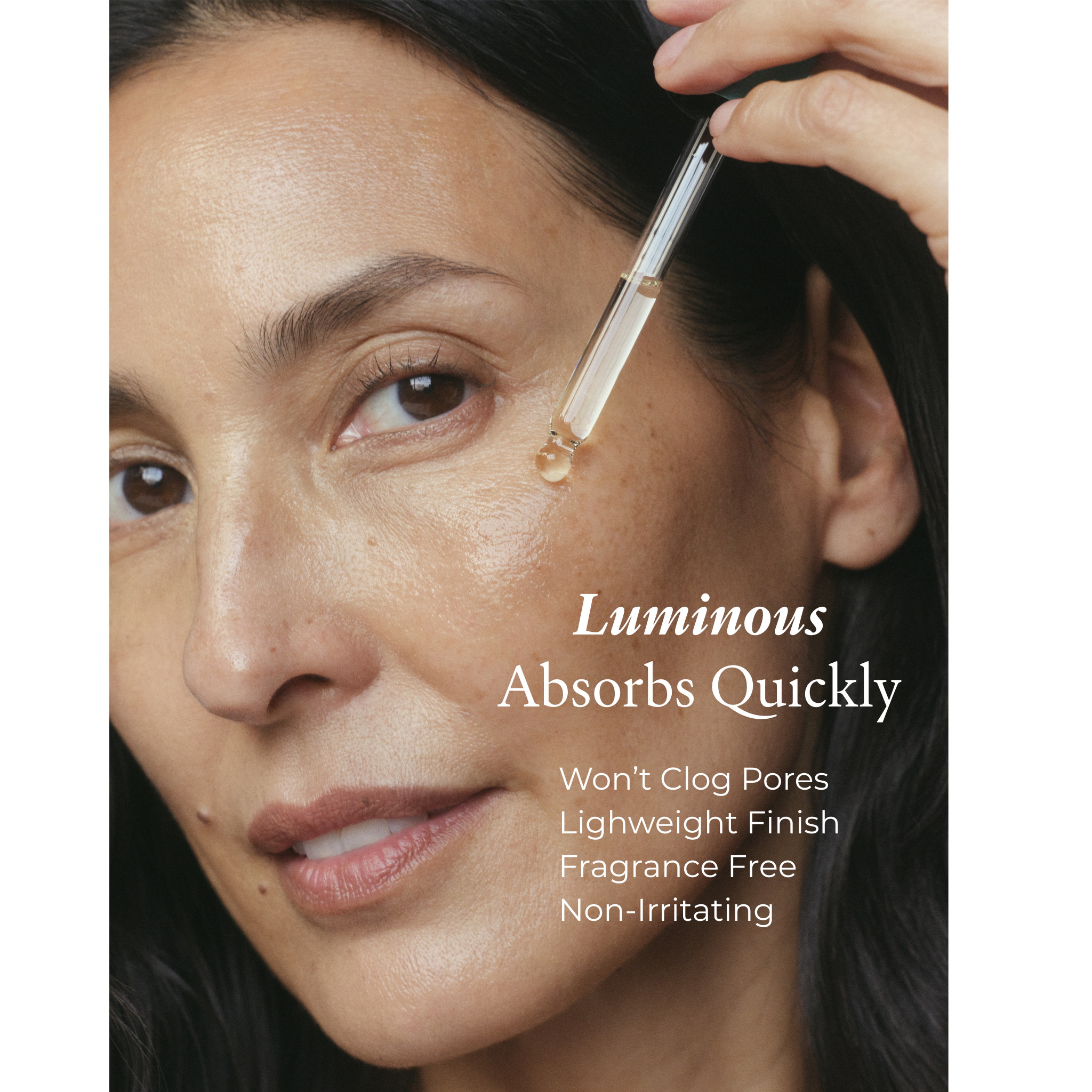Curious about estrogen face cream or estriol face cream? As more women seek skincare that addresses the hormonal changes of perimenopause and menopause, interest in topicals that contain hormones is on the rise. But with limited studies, evolving regulation, and safety concerns, many women are also asking: Is this the right solution for me? And if not—what are the best alternatives for supporting my skin?
Below, we’ll explore how estrogen face creams work, the skin benefits, the potential concerns surrounding them, and why a hormone-free approach to barrier repair and collagen stimulation could offer a better path forward.
What is estrogen face cream?
A quick science lesson: Estrogen is an umbrella term for several different forms of the hormone, among them estriol. You may hear the term “estrogen face cream” colloquially on social media, but the facial products trending today typically contain a form of estrogen called estriol. (You may see the word estriol on the packaging and in the product descriptions.)
Skincare infused with estrogen isn’t brand new — from the 1940s to the 1970s, brands like Helena Rubenstein and Elizabeth Arden sold versions that promised more youthful-looking skin. Eventually, the FDA began regulating the use of drugs in over-the-counter beauty products.
The estriol creams available today require a prescription, but are widely available from several new telehealth companies specializing in the treatment of menopause.
Estriol vs. Other Forms of Estrogen in Skincare
Not all estrogen creams are the same:
How do estrogen face creams work?
Estrogen plays a critical role in many of the body’s systems, even your skin. Estrogen supports the skin in several ways: it increases collagen synthesis, enhances moisture retention, strengthens the skin barrier, and reduces inflammation. As estrogen declines in perimenopause, these processes slow, leading to visible changes in skin health.
Topical estrogens aim to kick your skin back into gear by stimulating the estrogen receptors in the skin. While there are a small number of studies that do show some promise, (one of them sponsored by a company that sells an estriol cream), there are other studies that question the effectiveness of topical hormones for treating the signs of aging, like dryness, fine lines, wrinkles, unevenness, and sagging.
Another complicating factor? “The studies we do have run the gamut between creams that contain estriol, estradiol, and compounded estrogens, so even if they do show promise it is tough to know what kind of estrogen might work best, and in what dose, and for whom,” says Dr. Heather Bartos, an OB/GYN, menopause expert, and author of Quickies: One Hundred Little Lessons for Living Sexily Ever After in Midlife.
Is estrogen face cream safe?
The short answer: We don’t know. The longer answer is complex. Let’s break it down.
1. Estrogen Face Creams are not FDA-approved. While vaginal estrogen has undergone extensive safety studies and is FDA-approved, there’s no such thing as an FDA-approved estrogen face cream. Why is that? They’re compounded medications, meaning they are whipped up in pharmacies or by physicians rather than manufactured and sold by a pharmaceutical company. The FDA does not verify the safety, effectiveness, or quality of compounded drugs before they are marketed.
2. We don’t have long-term studies that prove estrogen face creams are safe. While we do have long-term safety data on vaginal estrogen creams, the research we we on estrogen face creams is limited.
3. We’re not totally sure how much estrogen is absorbed systemically through the skin on your face. We know that the amount of estrogen women absorb when using vaginal creams is very small. A recent study conducted by a company that sells an estrogen face cream showed that their cream did not raise the systemic hormone levels of study participants.
However, since some think the consequences of having too much estrogen in the body without mitigating the effects with carefully dosed progesterone could potentially be severe — some raise endometrial cancer as a possibility — some doctors say they want larger, long-term studies that prove the estrogen from face creams are not absorbed throughout the body before they feel comfortable prescribing them. Most experts agree that women with a history of hormone-sensitive cancers – breast, uterine, or ovarian cancers, for example – should speak to a doctor before using estrogen face creams.
Can I use vaginal estrogen cream on my face?
Some women consider this workaround, and there’s even a prominent dermatologist who says that she has been using the drug Premarin on her undereye area for years to thicken skin. However, some doctors advise against it since vaginal creams are not FDA-approved for use on the undereye area. “It may cause skin irritation or sensitivity,” says Dr. Bartos. “And we just don’t know yet how much estrogen you’ll absorb systemically.”
Who should avoid estrogen face cream?
Remember, these creams are medications, and it’s always a good idea to check with a doctor who understands the full picture of your health, your family history, any chronic conditions, and has a full list of what you’re already taking. Take extra care to consult a doctor if any of the following apply to you:
What are the best estrogen face cream alternatives?
For women seeking effective, non-hormonal alternatives, science-backed skincare can offer real support without the complexities of hormone-based products.
At Phosis, we’ve designed a skincare ritual specifically for women in perimenopause and menopause. Our clinically proven approach addresses the skin symptoms of perimenopause — a compromised skin barrier, dryness, redness, and texture.
Step 1: Calm Deep Hydration Restorative Cream
Calm Deep Hydration Restorative Cream is a clinically-proven, antioxidant-rich moisturizer designed to thoroughly nourish and support tired, parched skin. Can be used AM/PM on the face, neck, and decolletage to hydrate and boost moisture while reducing the appearance of fine lines. With a combination of highly active botanicals, this cream boosts firmness and reduces the appearance of redness. Calm includes a red algae extract that provides a mild cooling sensation to the skin after application. Ceramides help restore strong barrier function. A thick, lush, luxurious cream without heaviness or greasiness. Fragrance and essential oil free. Ideal for perimenopausal and menopausal skin.
In an independent clinical trial of Calm Deep Hydration Restorative Cream ...
Step 2: Luminous Ultrafine Revitalizing Face Oil
Luminous Ultrafine Revitalizing Face Oil brings clinically tested relief for dry skin. Can be used alone or over moisturizer to illuminate dull skin. Antioxidant-rich formula boosts softness and improves radiance. Restores suppleness. Skin protectant and emollient. Fragrance and essential oil free. Certified MyMicrobiome Friendly. Ideal for perimenopausal and menopausal skin.
Benefits
What are some skincare ingredients that act like a more “natural” or hormone-free alternative to estrogen?
These carefully chosen, science-backed botanicals and actives work synergistically to support hydration, firmness, elasticity, and overall skin vitality:
Jojoba Esters. Delivers soothing hydration, improves softness, and strengthens the skin’s moisture barrier.
Glycerin. A classic humectant that draws moisture into the skin, leaving it soft, supple, and hydrated.
Meadowfoam Seed Oil. Nourishes deeply, softens fine lines, and supports the skin’s natural barrier.
Ruttnera Lamellosa Oil. Conditions and hydrates, while improving texture and radiance with potential antioxidant benefits.
Watanabea Reniformis Oil. Rich in essential fatty acids, it strengthens the barrier, firms, calms redness, and supports regeneration.
Hydrolyzed Lupine Protein. Boosts firmness, improves tone and texture, and enhances skin thickness.
Engelhardtia Leaf Extract. An antioxidant-rich extract that improves elasticity, softness, and barrier resilience.
Red Algae Extract. Deeply moisturizing and protective, with redness-reducing and antioxidant properties.
White Truffle Extract. A luxurious hydrator that firms, improves tone, and softens fine lines with skin-thickening benefits.
Acetyl Hexapeptide-8. A peptide that visibly lifts, improves skin volume and elasticity, and refines the jawline.
Vitamin E (Tocopherol). A powerful antioxidant with emollient properties, especially potent when combined with Vitamin C.
Linoleic Acid. Smoothes, softens, calms inflammation, and supports the skin's natural moisture balance.
Phytosterols. Help soothe, hydrate, and soften sensitive or irritated skin.
Phospholipids. Moisturizing, protective, and rich in antioxidants that support skin health.
Bisabolol. A natural compound from chamomile, it soothes, heals, and protects skin from daily stressors and irritation.
Ginger Root Extract. An antioxidant-rich, anti-inflammatory botanical that improves tone and works synergistically with Bisabolol to calm redness.
Aloe Vera (Leaf Juice / Gel). Revered for its soothing, hydrating, and wound-healing benefits, ideal for inflammation-prone skin.
Ceramides (Ceramide NP). Strengthen the skin barrier and restore moisture retention.
Ectoin. A powerhouse hydrator with soothing, anti-inflammatory benefits.
Glyceryl Behenate. Prevents water loss, softens skin, and enhances formula smoothness.
Sunflower Seed Wax and Oil. Calm, hydrate, and support the barrier—especially beneficial for sensitive or dry skin.
Rice Bran Extract. Helps skin retain moisture, improving softness and smoothness.
Rosemary Leaf Extract. Smoothes fine lines, reduces inflammation, and boosts the skin’s resistance to environmental stress.
The Bottom Line
Estrogen and estriol face creams may seem like a promising territory to explore in the pursuit of youthful-looking skin, but for now, they come with complexity. Whether it’s safety concerns, personal preference, or a desire for long-term support without hormonal interference, many women are looking for something different.
At Phosis, we’ve created that alternative. Through formulas that contain barrier-repairing ceramides, antioxidants that boost collagen production and soothe redness, and a cutting-edge peptide to make your skin appear more lifted and refined, Calm and Luminous are designed to give you gorgeous skin in midlife and beyond. Hormone-free. Science-forward. Luxuriously effective.















